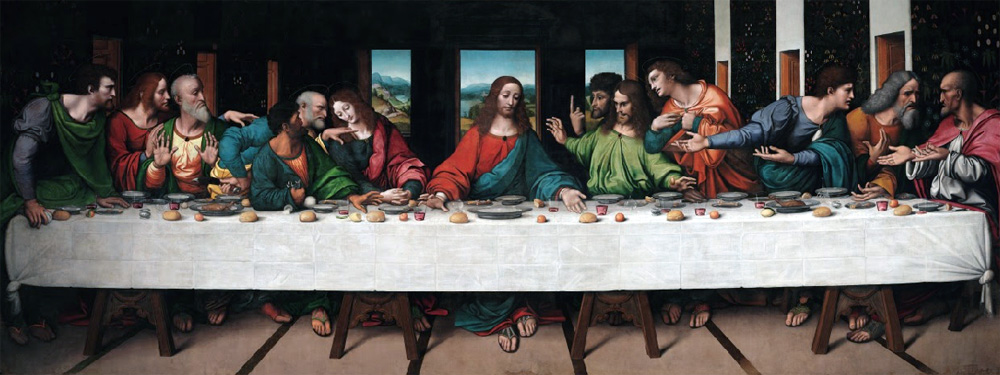Traditional Catholic teaching states that during the Mass, the bread and wine are mysteriously transformed into the Body and Blood of Jesus Christ. In Catholicism, this miraculous change is called “transubstantiation.” This means that once the sacred words of Consecration are spoken there is a real, total cosmic transmutation of the blessed elements.
Even if the bread (usually a small, plain, tasteless, white cracker) and the wine (red wine with a little water added) look, smell, taste, and can be handled in exactly the same way as before down to the subatomic level, they have become something altogether different and divine.
The “Real Presence” of Christ being in the Eucharist is one of the key beliefs of Roman Catholicism and one that scientifically-educated outsiders find most superstitious and indeed, laughable. Theologians have tied themselves in knots to defend the notion against the assaults of unbelievers and the evidence of their own senses alike.
Some, like Thomas Aquinas, have gone to great lengths defining the difference between “accidents” – the outward appearance – as opposed to the essence of the “substance” – the true metaphysical nature of the bread and wine. While such distinctions may have wowed divinity students in the Middle Ages, such mental gymnastics rarely raise an eyebrow in today’s digital world. All physical transformations require energy; if no change can be detected by any instrument, then nothing physical has happened, not even by magic. The only thing that is different in the bread and wine is how believers react to them.
Attempts to maintain the “reality” of Christ’s transforming presence while not totally denying the utter absence of change of physical appearances have led to numerous modifications of the doctrine by theologians over the centuries: “consubstantiation”, “transignification”, and so on, but every attempt to reduce the dogma to some kind of symbolic reading has failed and been rejected by the Catholic Church.
If there is a metaphysical transformation that takes place, however, perhaps believers should be relieved that it is invisible. All gory stories of Eucharistic miracles aside, few Christians would want to face the awful, cannibalistic reality of drinking human blood and choking on a wafer of raw human flesh. Yet isn’t that what the Savior commanded?
Jesus did indeed identify the loaf of bread as his body, and the cup of wine as his blood, and told the disciples, “Do this in remembrance of me.” [Luke 22:19]. Yet earlier, in John’s Gospel, “Jesus said to them, “I am the bread of life. Whoever comes to me will never be hungry, and whoever believes in me will never be thirsty.” [John 6:35]
Hearers were scandalized:
The Jews then disputed among themselves, saying, “How can this man give us his flesh to eat?” So Jesus said to them, “Very truly, I tell you, unless you eat the flesh of the Son of Man and drink his blood, you have no life in you. Those who eat my flesh and drink my blood have eternal life, and I will raise them up on the last day; for my flesh is true food and my blood is true drink. [John 6:52-55]
While “true food” and “true drink” might imply a metaphysical change, this could just be a clever turn of phrase by Jesus, for bread and wine are literally food and drink. The solution of this mystical conundrum may be quite simple.
In the symbolic code of the Early Fathers, “bread” can mean “teachings; word of God and his wisdom” and wine means “doctrine, dogma” and when wine is mixed with water (the way it was most often consumed in ancient times) is identified as “mystical insights“. This makes sense as the seed of the Word which is gathered together, ground into flour and baked into bread is like the way raw expositions are processed into principles which become consistent messages. Every bite of bread, divided and shared among believers, provides spiritual nourishment. Likewise, wine is made from the fruit of the vine – which symbolizes Jews or humanity as a whole – and transformed into a refreshing beverage that brings joy: a perfect metaphor for the saving doctrine of Christ.
So, “flesh” (or body) in this context may mean “literal interpretation of Scripture” while “blood” can mean “faith from text” or “knowledge of God“. As Origen put it, “For the doctrine of the Lord, which is very powerful, is called his blood.” [Origen, Commentary on the First Epistle of John, 7]
Symbolically then, Jesus may simply be saying nothing more than that his truth is in his teachings and in the doctrine he proclaims.
There is some evidence that this indeed was the case, for the Last Supper may not have been the First Communion. And the clue is in a remarkable mistake the Savior made.
To be continued…

